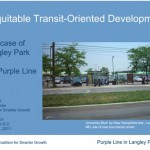The Purple Line is a 16-mile light-rail line which will circle and connect the region’s core communities inside the Capital Beltway, linking the spokes of the Metrorail system and connecting to Amtrak and MARC. The Purple Line offers a fast and high quality public transit alternative for suburb-to-suburb travelers, taking cars off local roads and the Beltway, relieving the burden of traffic congestion, and helping curb greenhouse gas emissions.
Transit-oriented development near new Purple Line rail stations would promote the revitalization of inner-suburban neighborhoods. By focusing development in inner-Beltway communities through a connected network of high quality transit stations, we can anchor our older communities, enhance property values, and bring new housing and business opportunities to underserved parts of the region.A high quality light rail line will foster job growth in Silver Spring and Prince George’s County, connect workers to jobs in Bethesda and the Red Line Corridor, and reduce traffic growth.The Purple Line will offer an alternative to traffic-choked commutes, cutting long east-west travel times.
While the new high quality transit connection is a great opportunity for communities along the route, it can also pose challenges by pushing up housing and commercial space price that could lead to displacement. The Coalition for Smarter Growth is a member of the Fair Development Coalition and Purple Line Corridor Coalition, who have been working to create a community compact to ensure that investment in the community benefits existing residents and small businesses.
History of the Purple Line
- August 4, 2016: Just four days before Maryland was set to sign the agreement to build the Purple Line, a federal judge ruled that the environmental assessment should be redone to account for declining Metro ridership.
- June 15, 2016: US DOT announced a $874.6 million loan to the Purple Line Transit Partners through the Transportation and Infrastructure Finance and Innovation Act (TIFIA). This low-interest loan will allow the private entities to invest as much as they can in the project and spend efficiently.
- April 6, 2016: The P3 contract was unanimously approved by the Maryland Board of Public Works. The contract, worth $5.6 billion over 36 years, will be administered by the Purple Line Transit Partners and several government agencies.
- December 8, 2015: Four teams of private companies submitted the second portion of their bids to build and run the Purple Line. The first section of the bids, the design portion, was due in early November, with the financial portions of the bids due in December. With all four bids submitted, the state could pick and begin talks with a winner by mid-January 2016.
- November 30, 2015: Carr Properties presented a proposal to redevelop the Apex Building at a public hearing. The Apex Building sits on top of the future Bethesda Purple Line Stop. Redevelopment of the building could lead to the construction of the optimal station design, as well as a new tunnel for the Capital Crescent Trail.
- August 14, 2015: Prince George’s County agreed to pay an additional $20 million to build the Purple Line. This comes after Montgomery County agreed to pay an $40 million in July, shoring up the last of local funding for the project. According to the agreement, Construction will begin in Prince George’s County and the Purple Line primary command center will be located within the county as well.
- June 25, 2015: Governor Hogan announced that the state would be moving forward with the project. As part of the project’s progression, Montgomery and Prince George’s counties are being asked to contribute more money towards the Purple Line’s construction. The private concessionaire is also being asked to contribute more. Hogan announced several costs savings for the project, including reduced headways for trains (6 minutes to 7.5 minutes) as well as the removal of one of the storage yards from the original plan.
- April 20, 2015: The updated Purple Line preliminary economic impact study was released. The study, authored by a consultancy and commissioned by Montgomery and Price George’s Counties, concluded that the Purple Line will bring “opportunities to fundamentally change the character of business in the area,” including fostering small business growth, as well as $635 million annually in increased federal and state income tax and property tax payments.
- April 20, 2015: The Washington Post editorial board published an article urging Maryland Governor Larry Hogan to move forward with the Purple Line. The editorial board pointed to the Purple Line as an opportunity for the Governor to make good his campaign pledge to strengthen Maryland’s economy. The Washington Post also cited the Purple Line’s “potential as a catalyst in rejuvenating and reviving older, close-in suburban neighborhoods that have stagnated as newer communities outside the Beltway have flourished.”
- March of 2015: Over 150 elected officials, community leaders, and business leaders gathered for Transit Night in Annapolis to call on legislators to keep fighting for the Purple Line and Baltimore’s Red Line. The broad coalition was united in the message to legislators and the Governor that the transit lines are expected to significantly stimulate economic activity and investment, and neither delay nor cancellation of these critical projects is acceptable. See photos of the event, here and here.
Resources
- A by-the-numbers look at the benefits of the Purple Line
- The Purple Line website: http://www.purplelinemd.com/en/
- Action Committee for Transit: http://www.actfortransit.org/
- Purple Line NOW!: http://www.purplelinenow.com/
- Purple Line Transit Partners: http://www.purplelinetransitpartners.com/
Latest Happenings
Group Argues New Transit Options Key To Growth In Bethesda, Montgomery

